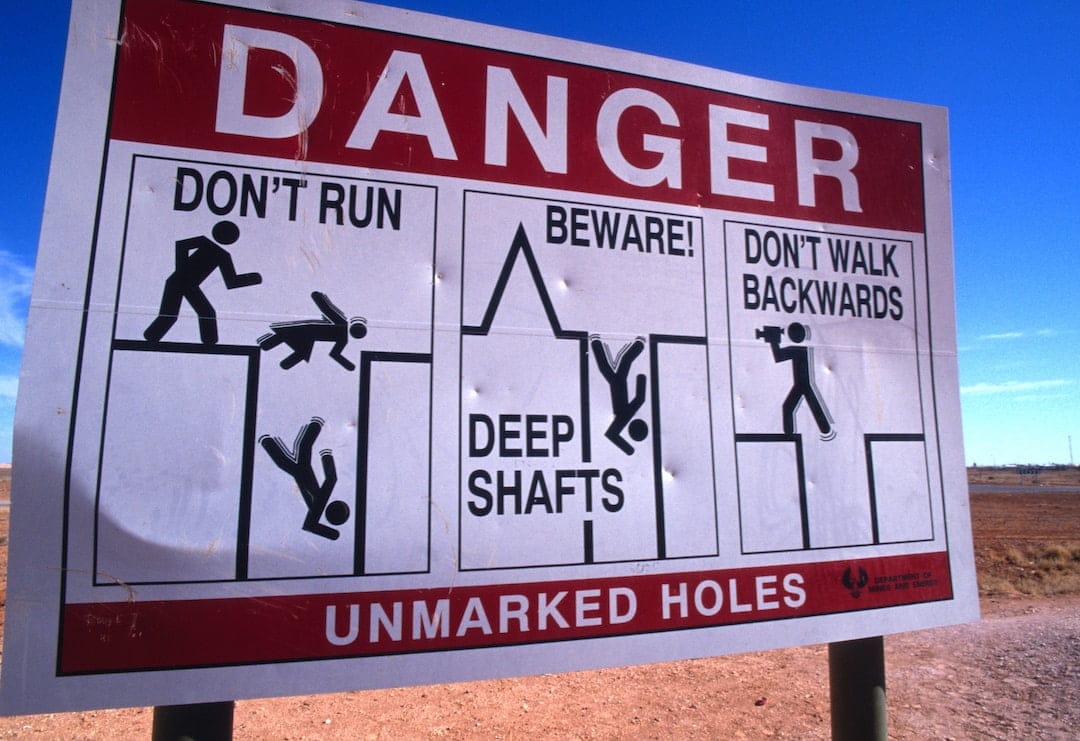“Out of the blue and into the black” is how soldiers described dropping into an enemy tunnel during the Vietnam War.
You get the idea, minus the terror, as you’re winched twenty dark metres down a narrow, Coober Pedy opal mineshaft.
Once you hit bottom, however, chances are there’s a spacious, well-lit cavern full of mining gear, a generator and maybe even an old crate to sit on. Welcome to the Coober Pedy underworld where a million mineshafts and galleries burrow, Swiss cheese-like, beneath the South Australian desert. So, what’s there to do, both above and below ground?

Dig Some History
Following the discovery of opal here in 1915 the surrounding desert plain was soon pocked with diggings and their conical mullock heaps. At the same time Coober Pedy — local Aboriginal language for “whitefella’s hole in the ground” — began to earn a Wild West-like reputation.
South Australian writer Max Anderson captures the spirit of place: “It was a polyglot, international outpost where everyone had opal in their eyes, although no one nationality had a monopoly on wild ways. Today, it’s a perfectly functioning Outback community. But you only have to gaze over that endless sea of pale mullock heaps — seen best under a full moon where they look like shark-fins — to realise that those roaring days made for one of Australia’s great Outback stories.”

Visit a Museum
No bucket descent involved. Several commercial museums here retell the early, hardscrabble days of riches or ruin, of cave-ins or a seam of glorious, translucent opal. The Old Timers Mine, hand-dug in 1916, offers a self-guided tour through its galleries and recreated troglodyte-like dwellings. Meanwhile, the larger Umoona Mine complex includes Aboriginal interpretive displays, a theatre and guided tunnel tours. You exit, naturally, through the gift shop and its trove of opal jewellery.

Home Sweet Dugout
More than half the town of around 2000 people lives underground. After gophering away all day in a mine or opal shop, families come home to roomy dwellings carved into the hillside. With a comfortable temperature of around 24 degrees Centigrade, these expandable dugouts have plenty of creature comforts. Some are almost mansions, lacking only a view from most rooms. Pick a soundtrack: Neil Young’s Out of the Blue or Bob Dylan’s Subterranean Homesick Blues?

Bend the knee
With its early reputation as a place beyond both the bitumen and redemption, plus a main street nicknamed Bolshevic Gully, you wouldn’t have expected many God-fearin’ institutions here. Nevertheless, some diggers did bring Old World religion with them.
Their churches — “dugouts”, of course — reflecting their ethnic origins have evolved into elegant catacombs honoring different creeds, with Greek and Serbian Orthodox as well as Anglican and Catholic chapels. Vaulted ceilings and stained-glass faux windows today make them meditative, calm places where you can duck in to pray or just retreat from the boulder-splitting summer heat.

Deep sleeping
Coober Pedy accommodation is predictably split-level, including underground hotels as well as above-ground motels, apartments, caravan parks and backpacker lodges. If you’re sleeping subterranean for the first time it might take a few minutes to shake off the mild claustrophobia of reclining deep-six, so to speak, in a room that has no windows and is as silent as, well, the grave. Distract yourself by admiring the beautiful patterns and veins in the clay walls. The best digs (so to speak) in town are probably the Desert Cave Hotel and Opal Inn.

Boot Hill
The town’s original cemetery near the Greek Orthodox Church goes back to 1921, while the more recent “boot hill” is dotted with poignant tombstones dating from the early 1970s. One much-photographed headstone adorns the grave of miner Karl Bratz. It’s an 18-gallon beer keg bearing the simple Outback epitaph, “Have a drink on me.”

Deep holes, tall stories
Those between- and post-War years of wild poker games, binges, brawls and jalopies loaded with gelignite might be long gone, but this is still a town of characters and their yarns — but no names, no pack-drill.
Pull up a beer at, say, the Outback Bar and Grill and soon you’re overhearing lines like, “I built a beautiful tunnelling machine. It cost me $70,000 and my marriage. But I’ve still got the machine.” Or a crusty local wag bunging it on for some wide-eyed backpackers: “You know why there’s no crocs left in Lake Eyre? The sharks got ‘em all.” What would the Outback be without a bit of bulldust?
If you enjoyed this piece on Coober Pedy, read more about Australia’s iconic outback destinations in our comprehensive guide.
Travelling to Coober Pedy
Rex Airlines flies to Coober Pedy direct from Adelaide. See the map below for details on travelling to Coober Pedy with Rex Airlines and book your flight here.










